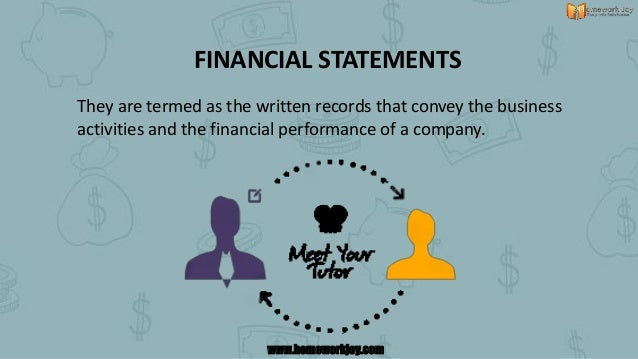Financial statements & analysis
Financial statements are written records that convey the business activities and the financial performance of a company.
The financial statements are used by investors, market analysts, and creditors to evaluate a company's financial health and earnings potential. The three major financial statement reports are the
Balance sheet
Income statement
Cash flow statement
Financial statements are often audited by government agencies, accountants, firms, etc. to ensure accuracy and for tax, financing, or investing purposes.
Sources of financial information
to effectively evaluate the financial performance of the business requires financial information from three sources: a balance sheet, an income statement and a cash flow statement.
Balance Sheet
A balance sheet is a statement of assets, liabilities and capital of a business or an organisation at a particular point in time, detailing the balance of income and expenditure over the preceding period.
In short, it shows what a company owns and owes. Additionally, it shows the amount invested in the business.
A balance sheet along with other financial statements helps to calculate the profitability, liquidity, leverage and efficiency of a business.
A balance sheet has assets on one side and liabilities and capital on the other side. Both the sides are always equal. Therefore, Assets = Liabilities + Capital.
Assets are what the company owns.
Liabilities are what the company owes.
And, capital is what has been invested in the business.
Income Statement
The income statement provides an overview of revenues, expenses, net income and earnings per share. It usually provides two to three years of data for comparison.
The income statement primarily focuses on a company’s revenues and expenses during a particular period. Once expenses are subtracted from revenues, the statement produces a company's profit figure called net income.
Also known as the profit and loss statement or the statement of revenue and expense,
Cash Flow Statement
A cash flow statement is a financial statement that summarizes the amount of cash and cash equivalents entering and leaving a company( i.e.- inflow and outflow of cash).The cash flow statement (CFS) measures how well a company generates cash to pay its debt obligations, fund its operating expenses, and fund investments.
Parties demanding financial information
1.Shareholders: In every public limited company, shareholders are the real owners of the company. Hence, they want to know the way of utilizing their investments and ascertain the profitability and financial strength of the company.
2. Debenture holders: Debenture holders are creditors of the company. They want to know the short term and long term solvency position of the company. Short term solvency is find out to know whether interest is payable by a company and long term solvency is find out to know whether principal amount is payable by a company.
3. Creditors: They are the suppliers of the raw materials and other necessary items on credit to the company. They are interested to know the liquidity position of the company.
4. Commercial Banks and Financial Institutions: Both commercial banks and financial institutions may lend both short term loan and long term loan. Hence, they are interested to know the short term solvency, long term solvency and profitability of the company.
5. Prospective Investors: Prospective investors who are going to buy the shares of the company in the very future. Hence, they are interested to know future prospects and financial strength of the company.
6. Employees: The regular payment of wages and salaries are based on the financial position of the company. Hence, they are interested to know financial position of the company
7. Trade Unions: The interest of the employees is protected only by the trade union. The interest of the employees can be protected if the financial position of the company is very strong. Hence, they are interested to know the financial position of the company.
8. Loyal Customers or Regular Customers: Some customers are loyal to the company since they are buying the products for a long period continuously. Hence, they are interested to verify the financial strength of the company.
9. Tax Authorities: Tax payable is based on the amount of profits earned by the company. Hence, the tax authorities are using the financial statements for calculating profits earned by the company.
10. Government Departments: Department of company affairs and other government departments are dealing with the industry in which the company is engaged are interested in the financial information relating to the company.
11. Research Institutions and Researchers: Social research institutions and researchers are using the financial statements. They analyze the financial statements to find out the role of each industry in economic development of a nation.
12. Economists: The economists are using the financial statements information for assessing economic conditions of workers.
13. Editorial Board of Financial and Economic Dailies and Periodicals: They need financial data in respect of every type of business units and hence, they are interested m financial statements.
14. Members of Parliament: Some public limited companies are started as Government Companies. Such Government Company financial statements are placed before the members of parliament. In such cases, Public Accounts Committee and Estimates Committee are interested in the financial information.
15. Professional Societies: It includes Chambers of Commerce and Industry Indian Accounting Association, Confederation of Indian Industry, Employers’ Associations and the like. These are very much interested to know the financial status of the business concern since they are formed to protect the respective types of business units.
16. SEBI and Stock Exchanges: These are interested to assess the financial position and level of performance of listed companies with a view to protecting the interests of investors.
17. Managers or Management: The management or manager has started to show keen interest in knowing the contents of financial statements which are used for internal management and control. Financial statements help the management in its various functions of planning, control, coordination and motivation.

Comments
Post a Comment